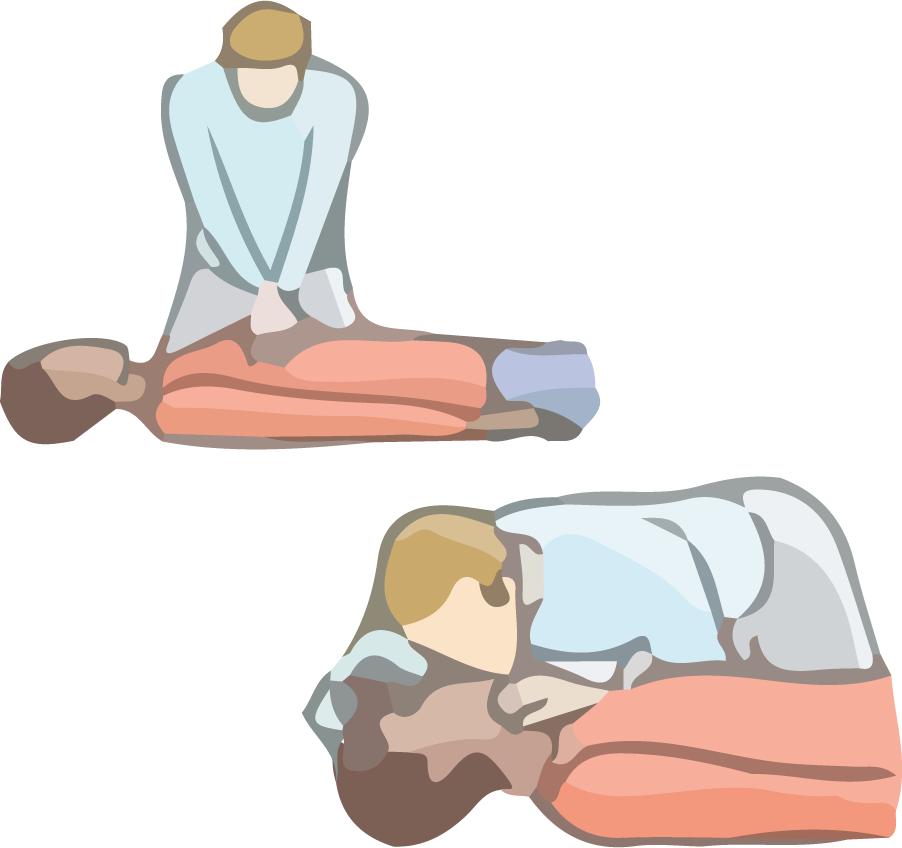Cardiac massage, also known as cardiopulmonary resuscitation (CPR) or chest compressions, is a vital first aid technique for maintaining blood flow to a person whose heart has stopped.
CPR consists of rapid, deep compressions of the person's sternum. Chest compressions create pressure on the heart, which causes blood to flow to the vital organs. Chest compressions should be performed at a rate of 100 to 120 compressions per minute with a depth of approximately 5 to 6 cm in an adult. In children and infants, the depth is adjusted according to their height and weight.
Cardiac massage should be combined with artificial ventilation, i.e., breathing air into the person's lungs. This provides oxygen to the vital organs. The frequency of ventilation must be adapted according to the age of the person and the technique used (mouth-to-mouth or face mask).
Cardiac massage should be performed quickly in the event of cardiac arrest to maximize the person's chances of survival. Health care professionals are trained in this technique and can perform it using a defibrillator to restore the person's normal heart rhythm.
It is important to note that CPR should be performed with care to avoid injury to the person's ribs and internal organs. It is also recommended that first aid training be taken to learn the proper technique and to be prepared to respond in an emergency.
Cardiac massage and compression-ventilation ratios
Cardiac massage is a vital intervention to try to restore normal heart function in the event of cardiac arrest. An important aspect of cardiac massage is the ratio of compression to ventilation. In this study, the authors sought to find out which compression-to-ventilation ratio was best for cardiac arrest victims by comparing the results of different studies.
What is cardiac massage?
Cardiac massage, or chest compressions, is a technique that involves pressing on a victim's chest in an attempt to restart the heart. It is called a "cardiac arrest" or "cardiopulmonary arrest" (CPA) when the heart stops beating and the victim is not breathing. Cardiac massage is one of the first things to do in the event of cardiac arrest to try to restore normal heart function.
What is a compression-ventilation ratio?
During CPR, breaths are also given to the victim. The compression-to-ventilation ratio describes the number of compressions given on the chest in relation to the number of breaths given. For example, if the ratio is 30:2, that means 30 chest compressions and 2 breaths.
Which compression-ventilation ratios are best?

In a scientific study published in 2017, the authors looked at which compression-to-ventilation ratio was best for victims who had suffered cardiac arrest. They looked at several different studies and compared different ratios to see which gave the best results in terms of survival and favorable neurological status.
They concluded that for adults, a 30:2 ratio was associated with better survival and favorable neurological status compared to a 15:2 ratio.
For children, they found that the 15:2 and 30:2 ratios yielded similar results and were associated with better survival and favorable neurological status compared to cardiac massage without ventilation (i.e., compressions only).
However, for children under one year of age, they found no significant difference between the 15:2 and 30:2 ratios and cardiac massage without ventilation.
Click here to learn more about the National Guidelines.
But what about the AED?
It is important to note that defibrillation is the only way to resuscitate a person in cardiac arrest. Cardiac massage and breaths can help maintain minimal blood flow to the brain and heart until defibrillation is possible, but only defibrillation can actually restore normal heart function. This study examined the effectiveness of different compression-ventilation ratios during cardiac massage, but it is important to remember that defibrillation is the most important intervention to perform in the event of cardiac arrest.
Summary of the study
- The objective of the study was to compare the effectiveness of different compression-to-ventilation ratios during cardiac massage (i.e., the number of chest compressions versus the number of breaths given) in victims of cardiac arrest.
- 41 studies were included in the review, with 13 being associated reports.
- For adults, a compression-to-ventilation ratio of 30:2 was associated with better survival and favorable neurologic status compared with a ratio of 15:2.
- For children, the 15:2 and 30:2 ratios yielded similar results and were associated with better survival and favorable neurological status compared with cardiac massage without ventilation (i.e., compressions only).
- However, for children under one year of age, they did not observe a significant difference between the 15:2 and 30:2 ratios and cardiac massage without ventilation.
Source
- Ashoor HM, Lillie E, Zarin W, Pham B, Khan PA, Nincic V, et al. Date de publication: June 2 2017 “Effectiveness of different compression-to-ventilation methods for cardiopulmonary resuscitation: A systematic review.” https://www.resuscitationjournal.com/article/S0300-9572(17)30243-5/fulltext [Last accessed January 6, 2023]